
Upgrading a Delta 50-760 Dust Collector with a Canister Filter
Dust collection seems to get people riled up for some reason. I haven’t a clue why. Searching forums and websites about it will reveal dozens of conflicting reports, differing opinions, information and misinformation. After spending all together too much time wading through all that stuff trying to find the useful ideas, I’ve come to the conclusion that most of it is simply noise. In an effort to not get too distracted with noise, I decided I want the following:
- A small system because I have a small space
- Collection piped into my machines, and to not have to muck about with hoses
- To control the chips and dust accumulation in my space, mostly because it’s a fire hazard
- If I can achieve good fine dust control, I’ll take it, but I’m going to keep wearing my N100 particle respirator most of the time
With that in mind, I decided to upgrade the gigantic filter bag on my Delta 50-760 to a canister filter. The OEM filter on a 50-760 is really quite large – the machine barely fits under my overhead door when it’s running.
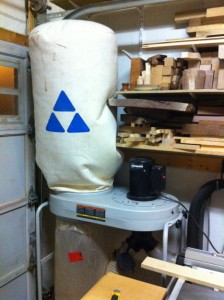 In the USA, there’s a well known company that specifically markets canister filters to woodworkers, but they told me they wouldn’t ship to Canada, so buying one of their filters meant dealing with a ship-to-the-border service and driving south. Closer to home, Busy Bee Tools sells a couple of cartridge filters with built-in flapper devices. I would have had to build an adapter ring to fit these filters to my 50-760, and I’m not convinced that the flapper is kind to the filter media. So I called up a local supplier and started asking dumb questions. Here’s what you need to know before ordering a filter from an industrial filter supplier:
In the USA, there’s a well known company that specifically markets canister filters to woodworkers, but they told me they wouldn’t ship to Canada, so buying one of their filters meant dealing with a ship-to-the-border service and driving south. Closer to home, Busy Bee Tools sells a couple of cartridge filters with built-in flapper devices. I would have had to build an adapter ring to fit these filters to my 50-760, and I’m not convinced that the flapper is kind to the filter media. So I called up a local supplier and started asking dumb questions. Here’s what you need to know before ordering a filter from an industrial filter supplier:
- How much space do you have? You need the vertical height and the diameter.
- Which way does the air flow? On single stage dust collectors, the dust is on the inside of the canister, flowing from inside to out. Apparently, this isn’t the way these filters are usually used.
- How are you going to seal the canister to the collector?
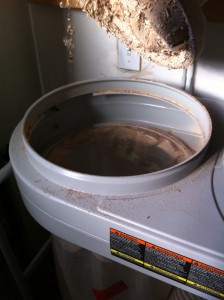 The Delta 50-760 has a slightly unconventional arrangement for its filter connections. The original filter and plastic collection bags are installed using something like a big snap ring that fits inside a channel in the body of the collector. Consequently, I had to find a different mounting approach.
The Delta 50-760 has a slightly unconventional arrangement for its filter connections. The original filter and plastic collection bags are installed using something like a big snap ring that fits inside a channel in the body of the collector. Consequently, I had to find a different mounting approach.
A salesperson spent a considerable amount of time explaining the options to me, for which I’m grateful. They installed a foam rubber gasket on the open end of the canister sized to my specifications, so it would sit on top of the ring on the collector. Here’s what the purchase order instructions looked like:
18 outside diameter x 12″ inside diameter, 26″ tall, 250 dimpled pleats of washable spun bond media, Outer support expanded metal for support, Dust to collect on inside of cartridge, Open/Closed configuration with 1/2″ wide rubber gasket centred on the open end. Inside diameter of the rubber gasket is 15 1/4″, outer diameter is 16 1/4″.
And this is what I ended up with:
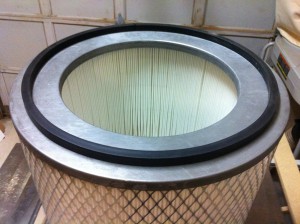 To mount the filter, I tossed around several ideas. I prototyped a couple of designs for steel clips and brackets but they were too much of a pain. In the end, I decided to use some 1/4″ ash scraps I had lying around. The gasket sits on top of the ring on the collector’s impeller housing. I drilled 4 holes in the open end of the canister ring inside
To mount the filter, I tossed around several ideas. I prototyped a couple of designs for steel clips and brackets but they were too much of a pain. In the end, I decided to use some 1/4″ ash scraps I had lying around. The gasket sits on top of the ring on the collector’s impeller housing. I drilled 4 holes in the open end of the canister ring inside 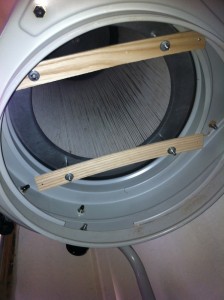 the folds of the pleats, ran 3 1/2″ hex bolts through that, and through two 1/4″ thick strips of ash with nylon lock nuts. I put some #4 wood screws through the ends on top of each of the strips to hook on the inside lip of the collector to keep the strips in place. You can see the points of three of the screws poking through in the picture – I ground them flat.
the folds of the pleats, ran 3 1/2″ hex bolts through that, and through two 1/4″ thick strips of ash with nylon lock nuts. I put some #4 wood screws through the ends on top of each of the strips to hook on the inside lip of the collector to keep the strips in place. You can see the points of three of the screws poking through in the picture – I ground them flat.
With this filter, the total filter area on the machine goes from 20.5 sq. ft. to a little over 180 sq. ft. That’s a big, big difference in static pressure loss. That loss has to be balanced out by ducting on the suction side so the machine doesn’t draw too much air for it to handle.
I’m planning to deal with this by adding a pre-separation stage before the inlet using Phil Thien’s design. I actually already built one of these, but in a fit of stupidity, I measured only once, and the finished separator was unfortunately too large to fit under the impeller housing on the collector. Not wanting to give up floor space to a trash can separator, it is now collecting ordinary dust on a shelf rather than collecting wood dust.
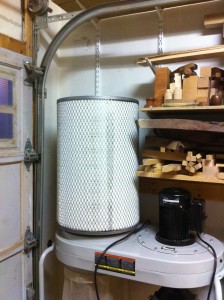 Completely unscientifically, I’d say that the suction I’m getting is significantly improved. Furthermore, the pleated filter is drastically smaller than the OEM bag, and it doesn’t move when the machine turns on, so those turning blocks that I have on the shelf no longer get knocked over when I start it up, and I’ll be able to rearrange those shelves to reclaim the space above the canister.
Completely unscientifically, I’d say that the suction I’m getting is significantly improved. Furthermore, the pleated filter is drastically smaller than the OEM bag, and it doesn’t move when the machine turns on, so those turning blocks that I have on the shelf no longer get knocked over when I start it up, and I’ll be able to rearrange those shelves to reclaim the space above the canister.
Comments: 4
Thanks for the write-up. A couple questions:
1. Was there any difference in noise of your DC after the upgrade? I’m wondering if the drop in static pressure put less load on your motor, and hence less noise.
2. Can you please elaborate on the ducting changes you made to balance out the drop in static pressure?
Hi Cecil,
To answer your questions:
1) Decreasing the static pressure loss increases the airflow. Counterintuitively, this actually increases the load on the motor. I’ve not quite wrapped my head around why this is the case but it is easy to test with an ammeter. I didn’t measure for a noise difference, but I also didn’t notice any.
2) With my setup, when both legs of the Y adapter included with the machine are open at the same time, the airflow is too high. I checked this with an ammeter and it exceeded the rated amperage on the motor. Running like that is a bad idea so I rearranged my blast gates to prevent any chance of running over the rated limits. The same can happen on really short, straight duct runs.
Derek
[…] I discovered that the whistling was the sound of massive amounts of air blasting between my canister filter and the mounting ring on my Delta 50-760 dust collector. Confused, I shut off the dust collector and finished my jointing. I figured that the canister […]
[…] an air filter’s job is to remove particles from air. Sounds silly to say it, but after you install a canister filter on a dust collector, you’re going to find yourself having to clean it, especially with a […]
Comments are closed.